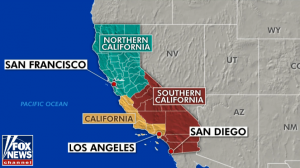The movement to slice up the state of California is reeling from internal clashes over what’s the best way to rearrange the state.
The Cal 3 measure, which seeks to break up America’s most populous state into three smaller states, recently gathered enough support to earn the right to appear on the Nov. 6 state election ballot, giving voters a historic chance to improve their representation on the national level.
But rather than get behind the upcoming vote, the separatist movement has fractured into multiple camps, each offering their own plans and criticizing each other for unfair dividing lines, the Washington Times reported.
Paul Preston, vice president and co-founder of the New California movement that want a two-state solution in California, based on rural-urban lines, says venture capitalist Tim Draper’s partition plan — the one on which voters will vote in November — wouldn’t address the issue of voter representation, as it would merely create two deep blue states and one swing state.
“With Draper, he makes sure every area has an urbanized zone that will ultimately be blue. You still have the rural-urban thing going on in his formula,” Preston told the Times. “The rural people will be shafted again.”
Yes California’s Louis Marinelli, meanwhile, opposes both the Draper and Preston initiatives, claiming all of them are just Republican plots to “chip away at the voice California lends to the republic as a solid blue state.”
Marinelli’s plan, dubbed Calexit, seeks to make California a wholly independent country and secede from the U.S. altogether – a step too far for other separatists.
“That’s secession. That’s what happened in the Civil War,” Preston said, nothing that his group would not support the initiative. “They want to create a new country, and that’s just not going to happen. First of all, it’s illegal under our Constitution. There’s no base out here to support that.”
Separatists have long argued that the current state of California is too big to function and address local problems.
In May, the U.S. Commerce Department said that California now boasts the world’s fifth-largest economy, surpassing that of Britain, the Sacramento Bee reported.
“I think the same type of voter frustration that leads people to Donald Trump or Bernie Sanders is the fuel behind these types of efforts,” Dan Schnur, professor at USC’s Annenberg School of Communications, told the outlet. “When you’re one of 40 million people, you don’t feel like you’re getting enough attention, and this [Cal 3] is a solution that will give you three times as much attention.”
The Cal 3 initiative managed to attract more than 400,000 signatures and paving the way to appear on the ballot in November, but other separatists say they are unlikely to achieve much.
“The three Californias measure is dead on arrival,” said Preston. “It’s not constitutionally sound, and everybody recognizes it. Everybody I’ve been talking to — and I get flooded because we’ve got 50 counties engaged in our program — everybody’s absolutely appalled by it.”
Preston’s New California group, meanwhile, is set to hold a July 21 constitutional convention and expect to make a case to the state legislature so the lawmakers can then proceed to split the state. He argues that the only way to achieve a partition of California is to follow the U.S. Constitution’s Article IV, Section 3, which states that no new states can be created “without the Consent of the Legislatures of the States concerned as well as of the Congress.”
The Cal 3 measure, if successful, would ask the governor to ask Congress approval and then leave the rest of the process to the state legislature.
“I think the rest of the country will just want to do what’s right for California,” Draper, who will bankroll the Cal 3 initiative, told Fox News’ Tucker Carlson back in April.
“It takes up the same land mass as 15 states on the East Coast. The population is the equivalent of an average of six or seven states. So I think it’s appropriate to have California represented by at least three states.”
Source: foxnews
Ask me anything
Explore related questions





